INTRODUCTION
MATERIALS AND METHODS
Cell culture
Western blot analysis
Wound healing assay
Detection of cell proliferation
Immunofluorescence staining for LC3
Tumorigenicity experiments in nude mouse
Immunohistochemistry
Terminal deoxynucleotidyl transferase dUTP nick end labeling (TUNEL) assay
Statistical analysis
RESULTS
HYP induces the upregulation of HIF-1α and Bcl-3 protein in gastric cancer cells
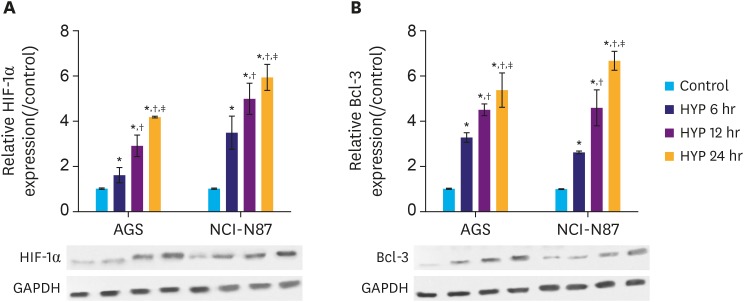 | Fig. 1HYP induces HIF-1α and Bcl-3 protein in gastric cancer cells. (A) Relative expression of HIF-1α in AGS and NCI-N87 cells was analyzed by western blotting. (B) Relative expression of Bcl-3 in AGS and NCI-N87 cells was analyzed by western blotting. GAPDH was used as a loading control.HIF-1α = hypoxia-inducible factor-1α; Bcl-3 = B-cell lymphoma 3; HYP = hypoxia; GAPDH = glyceraldehyde 3-phosphate dehydrogenase.
*P<0.05 (compared to control); †P<0.05 (compared to HYP 6 hours); ‡P<0.05 (compared to HYP 12 hours).
|
Bcl-3 knockdown reduces the migration and increases the chemosensitivity of gastric cancer cells
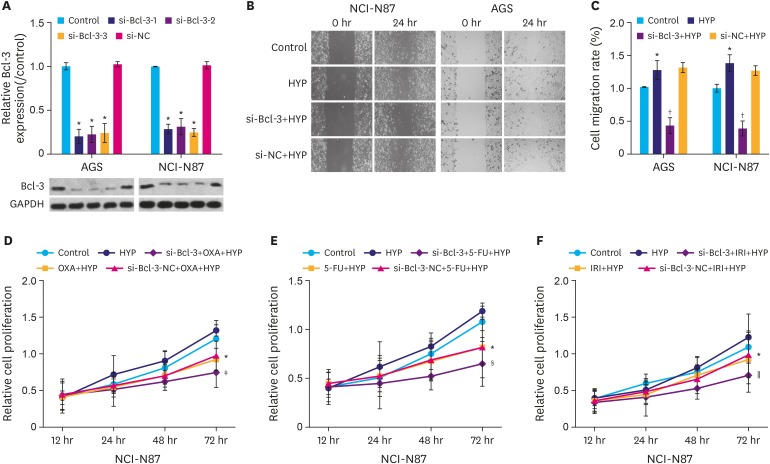 | Fig. 2Knockdown of Bcl-3 reduces the migration and increases the chemosensitivity of gastric cancer cells. (A) AGS and NCI-N87 cells were transfected with si-NC, or si-Bcl-3-1/2/3. Relative expression Bcl-3 in AGS and NCI-N87 cells was analyzed by western blotting. GAPDH was used as a loading control. (B) Cells were treated with HYP/si-Bcl-3 transfection. Wound healing assay was used to assess the migration of AGS and NCI-N87 cells. (C) Quantification of cell migration in AGS and NCI-N87 cells. (D) NCI-N87 cells were treated with or without OXA under HYP and MTT assay was used to detect cell proliferation. (E) NCI-N87 cells were treated with or without 5-FU under HYP and MTT assay was used to detect cell proliferation. (F) NCI-N87 cells were treated with or without IRI under HYP and MTT assay was used to detect cell proliferation.Bcl-3 = B-cell lymphoma 3; GAPDH = glyceraldehyde 3-phosphate dehydrogenase; si-NC = si-negative control; si-Bcl-3 = si-RNA-Bcl-3; HYP = hypoxia; OXA = oxaliplatin; 5-FU = 5-fluorouracil; IRI = irinotecan.
*P<0.05 (compared to control); †P<0.05 (compared to HYP); ‡P<0.05 (compared to OXA+HYP); §P<0.05 (compared to 5-FU+HYP); ∥P<0.05 (compared to IRI+HYP).
|
Bcl-3 knockdown decreases HYP-induced autophagy
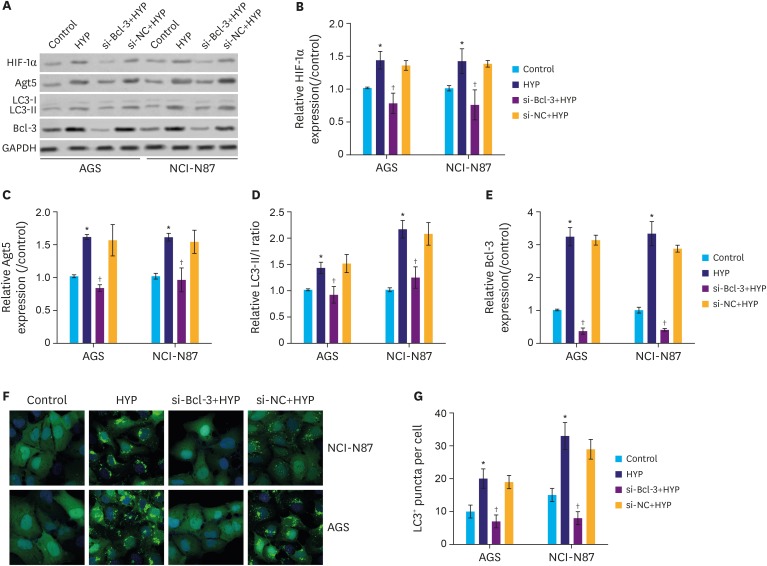 | Fig. 3Knockdown of Bcl-3 decreases HYP-induced autophagy. Relative expression of HIF-1α, Atg5, and LC3 were analyzed in AGS and NCI-N87 by western blotting. (B-E) Quantification of the relative protein levels of HIF-1α, Atg5, Bcl-3, and LC3 in AGS and NCI-N87 cells. (F,G) Immunofluorescence assay for LC3. LC3 positive puncta in individual cells are shown.Bcl-3 = B-cell lymphoma 3; HIF-1α = hypoxia-inducible factor-1α; HYP = hypoxia; si-Bcl-3 = si-RNA-Bcl-3; si-NC = si-negative control; GAPDH = glyceraldehyde 3-phosphate dehydrogenase.
*P<0.05 (compared to control); †P<0.05 (compared to HYP).
|
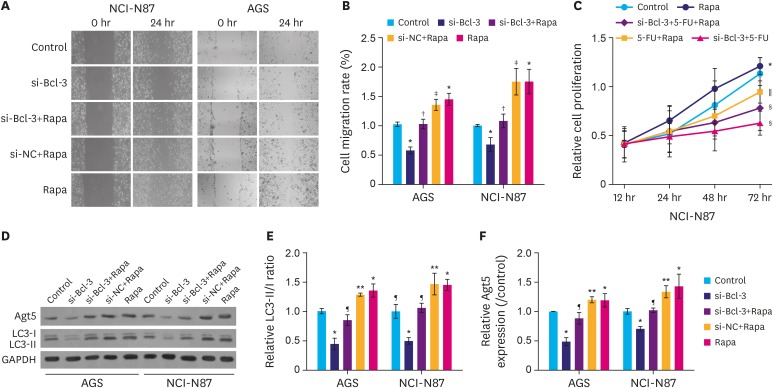 | Fig. 4Knockdown of Bcl-3 decreases hypoxia-induced autophagy. AGS and NCI-N87 cells were transfected with si-NC/si-Bcl-3 with or without Rapa. (A) Wound healing assay was used to analyze the migration of AGS and NCI-N87 cells. (B) Quantification of cell migration in AGS and NCI-N87 cells. (C) NCI-N87 cells were transfected with si-NC/si-Bcl-3 with or without 5-FU/Rapa, MTT was used to detect cell proliferation. (D) Relative expression of autophagy-related proteins in AGS and NCI-N87 were analyzed by western blotting. (E, F) Quantification of the relative protein levels of Atg5 and LC3 in AGS and NCI-N87 cells.Bcl-3 = B-cell lymphoma 3; si-Bcl-3 = si-RNA-Bcl-3; si-NC = si-negative control; 5-FU = 5-fluorouracil; Rapa = rapamycin; GAPDH = glyceraldehyde 3-phosphate dehydrogenase.
*P<0.05 (compared to control); †P<0.05 (compared to si-Bcl-3); ‡P<0.05 (compared to si-Bcl-3+Rapa); §P<0.05 (compared to 5-FU+Rapa); ∥P<0.05 (compared to si-Bcl-3+5-FU);); ¶P<0.05 (compared to si-Bcl-3); **P<0.05 (compared to si-Bcl-3+Rapa).
|
Bcl-3 knockdown regulates tumor growth through autophagy in vivo
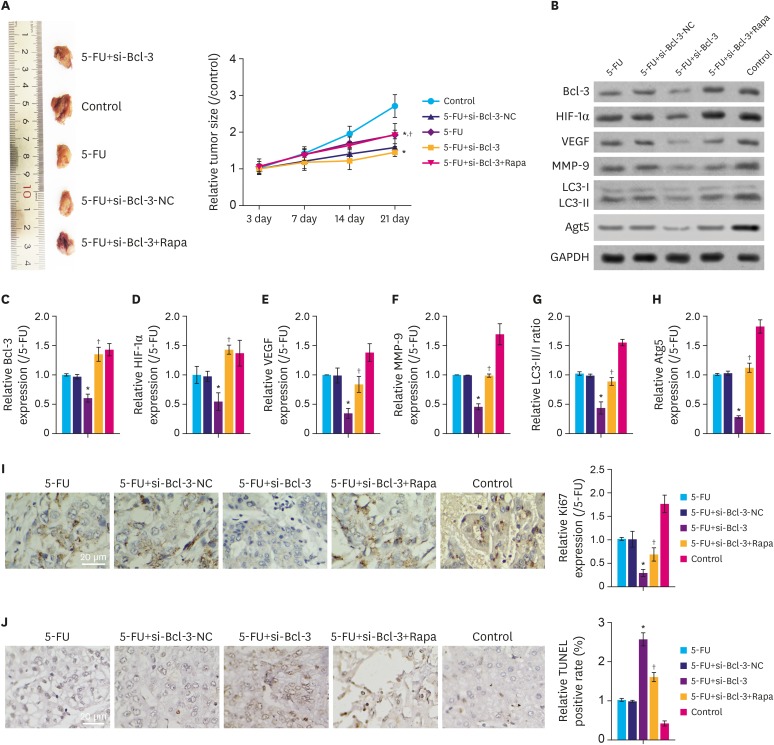 | Fig. 5Knockdown of Bcl-3 regulates in vivo tumor growth through autophagy. Tumorigenicity assay of AGS cells were performed using nude mouse. (A) Images of xenograft tumors derived from tumor-bearing nude mice injected with AGS cells with or without si-Bcl-3 transfection and 5-FU/Rapa. Tumor sizes of control and experimental mice are summarized in the line chart. (B-H) Relative expression of the associated proteins. (I) Immunohistochemistry for Ki67 and quantitation of the relative Ki67 expression. (J) TUNEL assay was used to detect apoptosis in the tumor tissue.Bcl-3 = B-cell lymphoma 3; HIF-1α = hypoxia-inducible factor-1α; VEGF = vascular endothelial growth factor; MMP-9 = matrix metallopeptidase 9; NC = negative control; si-Bcl-3 = si-RNA-Bcl-3; 5-FU = 5-fluorouracil; Rapa = rapamycin; TUNEL = terminal deoxynucleotidyl transferase dUTP nick end labeling; GAPDH = glyceraldehyde 3-phosphate dehydrogenase.
*P<0.05 (compared to control); †P<0.05 (compared to si-Bcl-3+5-FU).
|




 PDF
PDF ePub
ePub Citation
Citation Print
Print



 XML Download
XML Download